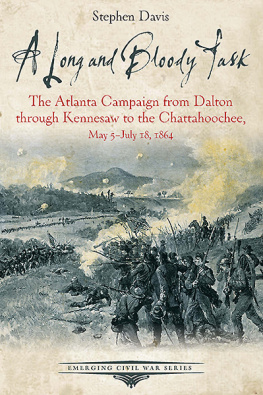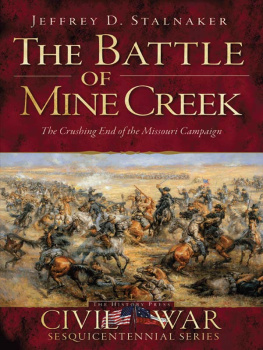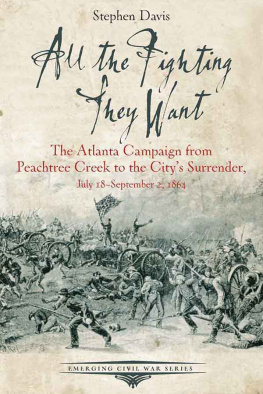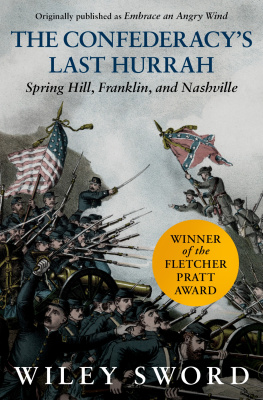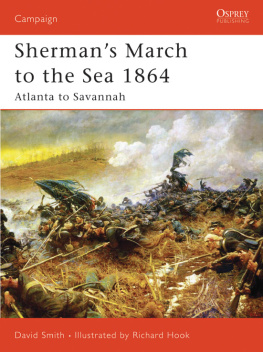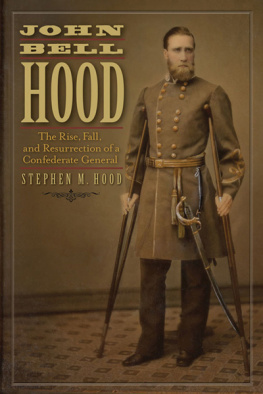PETER S. CARMICHAEL, CAROLINE E. JANNEY, and AARON SHEEHAN-DEAN, editors
This landmark series interprets broadly the history and culture of the Civil War era through the long nineteenth century and beyond. Drawing on diverse approaches and methods, the series publishes historical works that explore all aspects of the war, biographies of leading commanders, and tactical and campaign studies, along with select editions of primary sources. Together, these books shed new light on an era that remains central to our understanding of American and world history.
The Battle of Peach Tree Creek
Hoods First Effort to Save Atlanta
EARL J. HESS
THE UNIVERSITY OF NORTH CAROLINA PRESS
Chapel Hill
This book was published with the assistance of the FRED W. MORRISON FUND of the University of North Carolina Press.
2017 Earl J. Hess
All rights reserved
Manufactured in the United States of America
Set in Miller and Sentinel by Tseng Information Systems, Inc.
The University of North Carolina Press has been a member of the Green Press Initiative since 2003.
Cover illustration: The 111th Pennsylvania at Peach Tree Creek.
From John Richards Boyle, Soldiers True: The Story of the One Hundred and Eleventh Regiment Pennsylvania Veteran Volunteers, and of Its Campaigns in the War for the Union, 18611865 (1903).
Library of Congress Cataloging-in-Publication Data
Names: Hess, Earl J., author.
Title: The battle of Peach Tree Creek : Hoods first effort to save Atlanta / Earl J. Hess.
Other titles: Civil War America (Series)
Description: Chapel Hill : The University of North Carolina Press, [2017] | Series: Civil War America | Includes bibliographical references and index.
Identifiers: LCCN 2017007289| ISBN 9781469634197 (cloth : alk. paper) | ISBN 9781469634203 (ebook)
Subjects: LCSH: Peachtree Creek, Battle of, Ga., 1864. | Hood, John Bell, 18311879. | GeorgiaHistoryCivil War, 18611865. | United StatesHistoryCivil War, 18611865Campaigns.
Classification: LCC E476.7. H465 2017 | DDC 973.7/371dc23 LC record available at https://lccn.loc.gov/2017007289
For Pratibha and Julie, with love
Illustrations
William T. Sherman /
Joseph E. Johnston /
John Bell Hood /
Joseph Hooker /
John Newton /
William J. Hardee /
George H. Thomas /
Clement H. Stevens /
Alexander P. Stewart /
Benjamin Harrison /
William T. Ward /
Joseph Hooker on the Battlefield /
John W. Geary /
Charles Candy /
111th Pennsylvania at Peach Tree Creek /
Alpheus S. Williams /
Joseph F. Knipe /
Anson G. McCook /
Peach Tree Creek Battlefield /
Maps
Chattanooga to Atlanta /
Chattahoochee River Area /
Evening, July 17 /
Evening, July 18 /
Evening, July 19 /
Three P.M., July 20 /
Hardee versus Newton /
Featherston versus Ward /
Coburns Brigade /
Harrisons Brigade /
Woods Brigade /
Scott versus Geary /
Gearys Division at Start of Battle /
Gearys Division at End of Battle /
ONeal versus Williams /
Robinsons Brigade /
Knipes Brigade /
Reynolds versus McCook /
French versus Moore /
Midday, July 22 /
Preface
The midday sun was at its height on the afternoon of July 20, 1864, as the men of George H. Thomass Army of the Cumberland settled into positions south of Peach Tree Creek. The crossing had consumed many hours and was conducted in stages the day before and that morning. Now it was time for some of Thomass units to construct rude fieldworks, send out skirmishers, and consolidate their hold on the high ground just south of the stream. For other units, commanded by men who assumed there would be no fighting that day, there was an opportunity to lounge in the bottomland of the creek, fix a meal, and relax under the shade of trees.
But then, without warning, battle flags appeared from the woods south of Thomass new position, followed by division upon division of butternut-clad men. The Army of Tennessee was on the move, and its new commander, John Bell Hood, was making his first strike to save Atlanta. After falling back sixty miles from Dalton since early May, the Confederates attempted their first major attack on William T. Shermans army group as the enemy closed in on the outskirts of Atlanta. Hood hoped to take advantage of the fact that his enemy had just made a difficult crossing of Peach Tree Creek. His Confederates certainly took the Unionists by surprise. All along the developing battle front the Federals scrambled to get ready; two potentially dangerous gaps in the line of the Twentieth Corps were waiting to be exploited by the onrushing enemy, and some other bits of high ground still had not been secured by Union commanders along the line.
In short, there was reason for the Confederates to hope that Hoods plan might work to their benefit. Only two days in command of the Army of Tennessee, Hood had precious little time to acclimate himself to a position he had not wanted and for which he possessed few attributes to fill. But he did his best to plan, position, and inspire his men despite widespread dissatisfaction at the relief of their beloved general Joseph E. Johnston and the elevation of someone who had served in the Army of Tennessee for only four months. Whether his men could fulfill Hoods hope for a dramatic turnaround in Rebel fortunes during the Atlanta campaign would be worked out before dusk fell on that hot and bloody day of fighting north of the city.
This book tells the story of the battle of Peach Tree Creekthe battle of July 20, 1864, north of Atlanta. A successor to my studies of Kennesaw Mountain and Ezra Church, this book is also based on exhaustive research in primary sources and an examination of the ground. Its purpose is not only to detail the battles history in narrative fashion but to analyze and evaluate the major features of that history. Each phase of the Atlanta campaign possessed important aspects to explain the course of events from the May confrontation at Dalton to the final battle at Jonesboro in late August and early September. None of those phases were necessarily decisive in shaping the campaign, but all of them contributed to its contours and results. We need to understand each phase in its turn and how it contributed to the larger picture if we hope to understand one of the largest, most important, and most interesting campaigns of the Civil War.
The battle of Peach Tree Creek was heavily dominated by the sudden replacement of Johnston with Hood on July 1718. In that event the Army of Tennessee lost its most respected commander (although one who did not hesitate to discipline the troops with executions for desertion) and gained a man whose capabilities were largely unknown. William J. Hardee, the only one of the armys corps commanders with great experience in his job, was miffed at Hoods ascension to command. Hardees colleagues (Alexander P. Stewart and Benjamin F. Cheatham) had not yet fought a battle with their new corps commands. Hood mandated an overly complex movement en echelon by divisions, and the attack took place several hours later than planned. The Confederates advanced with little information about the placement of their enemy, knew nothing of a one-and-a-half-mile gap in Shermans line, and were ill-informed that Shermans left wing was closing in along the eastern approaches to Atlanta. That latter development forced Hood to curtail the fighting at Peach Tree Creek earlier than anticipated.





